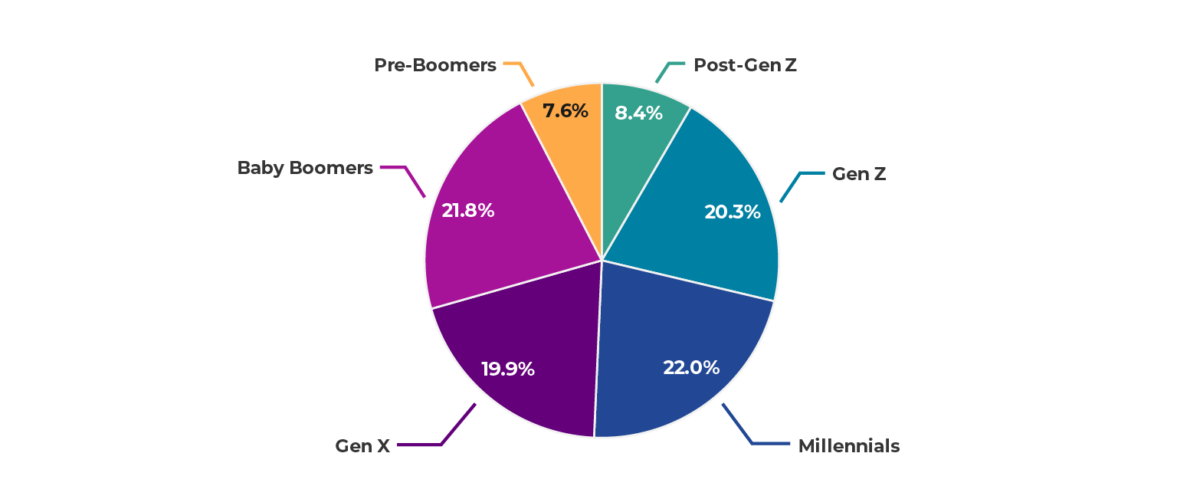The modern consumer market has changed, both in its makeup and behavior. Today, the American consumer market is the most diverse in its history. For instance, millennials are the largest generation, and in combination with Gen Z, more than 50% identify as racially diverse. Consumers have shifted their purchasing mindset from “Is this a good product?” to “Is this a good brand?” To keep pace with consumer expectations, brands need to consider all their potential consumers via multicultural marketing, and adapt their strategy to genuinely align with the modern consumer base.
In traditional marketing terms, historically there have always been two distinct segments: the general market (GM) and the multicultural market (MCM). In generic terms, the GM (or the “mainstream”) has been the equivalent of “non-Hispanic white consumers,” while the MCM has represented everyone else, segmented mostly into Black, Asian, Hispanic and other minority consumer groups.
In the past, some marketers were probably familiar with the separate approaches for each group when developing a program or campaign. It used to start with GM insights, a GM strategy, a GM brief, a media plan, a distribution strategy, etc. Generally, after the GM brief has been set, if the product/promotion is deemed important enough for diverse audiences, the Multiciltural Marketing strategy and briefs are established, incorporating cultural nuances and insights to make them more “relevant” for these audiences. This was the old approach and is certainly inappropriate for today’s consumers.
THE OLD MODEL
In the U.S. non-Hispanic whites represent the majority. In the past, some marketers considered this group as an example of how to craft MCM strategies. For decades, non-Hispanic whites established cultural norms. However, this approach is outdated and no longer makes sense. The mainstream (general market) has changed and no longer strictly represents non-Hispanic whites but is heavily influenced by multicultural groups.
Let’s take a look at some numbers:
- In the early 2000s, it was estimated that one in four people in the U.S. was a race other than white. It is projected that by 2060, this will shift to one in three people.
- Approximately 44 million people in the U.S. (almost 14% of the U.S. population) were born abroad.
- Millennials are the largest living generation in the U.S. (72.1 million) and, in combination with Gen Z and other younger generations, are more racially diverse than older generations, with close to 50% identifying as a racial or ethnic minority.
- More than 17% of all U.S. marriages are interracial.
- In 2010, the U.S. Census 10-year growth rate was +32% for the multiple-race population vs. +9% for the single-race population.
- The only racial and ethnic group projected to shrink in upcoming decades is the non-Hispanic white population.

Numbers pertain to July 1, 2019
Note: Birth years are as follows: Post Gen Z (2013+), Gen Z (1997-2012), Millennials (1981-1996)),
Gen X (1965-1980), Boomers (1946-1964), Pre-Boomer (1945 and earlier).
Source: William H. Frey analysis of Census Bureau population estimates released June 25, 2020.
Then, of course, there’s this number:
5 trillion
This number represents the estimated collective buying power of U.S. diverse segments as of 2018. It is now estimated that the buying power of U.S. Hispanic consumers alone is $1.9 trillion. In other words, if you’re not actively working to connect with these audiences at every turn, and in a way they will respect, they may not support your brand in the long run—and that’s not a gamble most companies can afford to make.
THE NUMBERS ARE COMPELLING, BUT WHAT DOES THIS MEAN?
In short, it means that if you still think of this when you picture the General Market consumer …

… you’re not on the right track.
THE GENERAL MARKET IS THE MULTICULTURAL MARKET
Actually, the new general market is the multicultural market (total market), and it’s reflective of consumers’ diverse backgrounds and cultures. Our content programs need to mirror that. The U.S. is more diverse now than at any other time in history, and we have to stay relevant by using a diverse and inclusive lens on every campaign, every promotion, every story and every piece of content. Diversity extends beyond strict definitions of language, race and ethnicity; instead, it embraces a true cultural movement.
Gilbert Dávila, chair of the Association of National Advertisers Multicultural Marketing and Diversity Committee, put it this way: “We can reach and connect with ALL consumers in relevant and meaningful ways ultimately lifting corporate growth. ALL is the critical word. Today’s modern family is highly multicultural by nature and our work must reflect that to be relevant and inclusive. Recognizing diversity is no longer enough—we must incorporate it and celebrate it. Everyone should feel included and valued.”

MULTICULTURAL MARKETING: THE NEW MODEL
To be clear, we’re not suggesting that everything you do resemble a United Colors of Benetton ad from the 1980s; authenticity here is crucial. Instead, it means leading with a total market mindset—or rather, a multicultural market—from the beginning. It means developing a strategy that embraces a diverse audience that is not only inclusive of all ethnicities and cultures but also across identities and abilities.
It means infusing the main brief with cultural insights. It means challenging the creative to authentically reflect cultural nuances. And finally, it means ensuring you have an internal staff that is reflective of the total market. It’s time to take a look at your team and ask if it’s more representative of the old status quo (mostly white) or truly diverse. The truth is that unless you invest in bringing diverse people, perspectives and cultures to the table, you’ll eventually be stuck with an outdated and irrelevant marketing program.
A note of clarification: This does not eliminate the need for focused MCM programs or campaigns (or departments and agencies) that speak to the individual multicultural segments. Different and distinct approaches are not only necessary for these audiences, but also respectful of their cultural identities. Specialized products and services, as well as targeted media, events, and sponsorships still require a separate multicultural effort. Some diverse audiences also may need content in languages other than English, or a combination of languages that reflect their biculturalism. A segmented approach in these cases still makes sense, but a GM campaign absent of these cultures does not.
WHAT BRANDS ARE ALREADY DOING THIS?
Walmart, Coca-Cola and McDonald’s are great examples of brands that adopted the total market approach early on, leading with multicultural insights to drive marketing strategy. But this shift in approach transcends retailers as well as the beverage and food industry reaching the finance, pharmaceutical, automotive and so many other industries. They all concede that it takes commitment and discipline but recognize that it’s critical to the success of their business.
THIS IS A LOT TO DIGEST—HOW DO I BEGIN?
Cultural shifts are often challenging to maneuver, but embracing them will be one of the crucial keys to a brand’s longevity. To start, do an honest self-assessment of your brand’s internal structure, strategy and content mix. Take a look and determine if they represent the total market of today or the general market of 15–20 years ago. If it’s closer to the latter, here are some things you can do to make positive changes:
- Infuse different cultures into all projects, in your staff and your creative output
- Consider creating a total market task force that does an internal gut check on strategy, briefs and creative
- Create narratives in which people see themselves
- Show people that we understand who they are and what they want
- Seek out and feature people, events and stories that aren’t covered everywhere else
- Create connections through a mix of tone and cultural touchstones to which people from diverse backgrounds can relate
As the U.S. continues to become more and more diverse as time progresses, it is vital to a brand’s success that they align with and represent the growth in diversity. Today’s consumer thought process has shifted from “Is this a good product?” to “Is this a good brand?” As you do some introspection into your staff, business and strategy, ask yourself, “What do I represent, and how do I communicate this?” Considering a total market approach will not only help your business, but it also will allow you to make an impact.

Note: This blog post has been updated from the original version published in 2016.
Sign up for our monthly newsletter to get more content like this.



